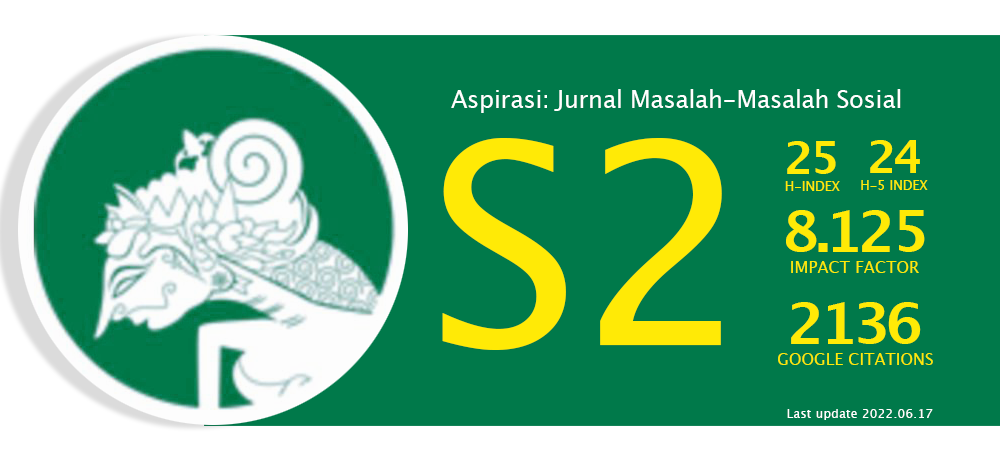How Adolescents Perceive Stunting And Anemia: A Qualitative Study In Stunting Locus Area In Yogyakarta Indonesia
Abstract
Persepsi merupakan interpretasi unik dari suatu situasi sebagai proses kognitif kompleks yang memengaruhi perilaku seseorang. Penelitian ini bertujuan untuk membahas persepsi remaja tentang stunting dan anemia. Penelitian ini dilakukan di wilayah lokus stunting yang mencakup Kabupaten Kulon Progo dan Gunung Kidul, Yogyakarta, Indonesia pada tahun 2020. Penelitian ini dilakukan dengan metode rapid assessment procedures (RAP) dengan wawancara mendalam. Sebanyak 33 orang terdiri dari 25 siswa SMP baik laki-laki maupun perempuan serta 8 guru, orang tua, dan tokoh masyarakat berpartisipasi dalam penelitian ini. Analisis data dilakukan berdasarkan tema definisi, penyebab, dampak, pencegahan, dan hambatan dalam penanggulangan stunting dan anemia. Berdasarkan hasil wawancara mendalam, beberapa remaja menyatakan bahwa anemia sama dengan tekanan darah rendah. Di antara hambatan untuk mengatasi anemia adalah remaja sering memiliki citra tubuh ingin menjadi lebih ramping, lebih kurus, membatasi makanan bergizi, kurang tidur, dan khawatir berlebihan terhadap tubuhnya. Ada beberapa kendala dalam mencegah dan mengendalikan stunting, antara lain tabu tentang makanan tertentu, persepsi stunting yang keliru, genetik sebagai penyebab utama, dan stigma. Namun, untuk mendorong persepsi ini, diperlukan dukungan serta strategi komunikasi, informasi, dan edukasi sehingga target penurunan stunting dapat tercapai. Tenaga kesehatan perlu merancang strategi komunikasi perubahan perilaku yang tepat untuk menanggulangi anemia dan stunting pada remaja.
Abstract
Perception is an individual’s unique interpretation of a situation as a result of a complex cognitive process that influences behavior. This study aims to explore adolescents’ perceptions of stunting and anemia. This qualitative study was conducted in Kulon Progo and Gunung Kidul Districts, Yogyakarta, Indonesia, in 2020. The study was carried out by rapid assessment procedures (RAP) using in-depth interviews. A total of 33 informants consists of 25 male and female of junior high school students, and 8 persons, including teachers, parents, and the community involved in this research. We thematically coded the data by definitions, causes, impacts, prevention, and obstacles in tackling stunting and anemia. This finding is that some adolescents state that anemia equals to low blood pressure. The barriers to prevent anemia are body image, lack of nutritious food intake, less sleep, and excessive upset. Meanwhile, stunting is a genetic problem, so if the parents are short, their children must be short too. To achieve the goal of reducing stunting, however, it is required to implement methods for communication, education, and information dissemination. So health professionals must develop suitable behavior change communication strategies.
Keywords
Full Text:
PDFReferences
Abbas, A. M., Fathy, S. K., Fawzy, A. T., Salem, A. S., & Shawky, M. S. (2020). The mutual effects of COVID-19 and obesity. Obesity Medicine, 19, 100250. https://doi. org/10.1016/j.obmed.2020.100250.
Abdullahi, L. H., Rithaa, G. K., Muthomi, B., Kyallo, F., Ngina, C., Hassan, M. A., & Farah, M. A. (2021, July 29). Best practices and opportunities for integrating nutrition specific into nutrition sensitive interventions in fragile contexts: A systematic review. BMC Nutrition, 7, 1–17.
Adelman, S., Gilligan, D. O., Konde-Lule, J., & Alderman, H. (2019). School feeding reduces anemia prevalence in adolescent girls and other vulnerable household members in a cluster randomized controlled trial in Uganda. The Journal of Nutrition, 149(4), 659–666.
Agustina, R., Wirawan, F., Sadariskar, A. A., Setianingsing, A. A., Nadiya, K., Prafiantini, E., Asri, E. K., Purwanti, T. S., Kusyuniati, S., Karyadi, E., & Raut, M. K. (2021). Associations of knowledge, attitude, and practices toward anemia with anemia prevalence and height-for-age z-score among Indonesian adolescent girls. Food and Nutrition Bulletin, 42(1_suppl), S92– S108.
Alzain, B. (2012). Anemia and nutritional status of pre-school children in North Gaza, Palestine. International Journal of Scientific & Technology Research, 1(11), 86–91.
Apriningsih, Madanijah, S., Dwiriani, C. M., & Kolopaking, R. (2020) ‘Determinant of Highschool Girl Adolescent’ Adherence to Consume Iron Folic Acid Supplementation in Kota Depok. Journal of Nutritional Science and Vitaminology, 66 (Suppl), S369–S375. https://doi.org/10.3177/ jnsv.66.S369
Balluck, G., Toorabally, B.Z. and Hosenally, M. (2016). Association between body image dissatisfaction and body mass index, eating habits and weight control practices among Mauritian adolescents. Mal J Nutr, 22(3), 389–401.
Beal, T., Tumilowicz, A., Sutrisna, A., Izwardy, D., & Neufeld, L. M. (2018). A review of child stunting determinants in Indonesia. Matern Child Nutr, 14(4), 1–10.
Beebe, J. (2001). Rapid assessment process: An introduction. Rowman Altamira.
Bhandari, N., Bahl, R., & Taneja, S. (2001). Effect of micronutrient supplementation on linear growth of children. British Journal of Nutrition, 85(S2), S131–S137.
Branca, F., Piwoz, E., Schultink, W., & Sullivan, L. M. (2015). Nutrition and health in women, children, and adolescent girls. BMJ (Clinical research ed.), 351: h4173, 27–31.
Briggs, M. M., Hopman, W. M., & Jamieson, M. A. (2007). Comparing pregnancy in adolescents and adults: Obstetric outcomes and prevalence of anemia. Journal of Obstetrics and Gynaecology Canada, 29(7), 546–555.
Bundy, D. A. P., de Silva, N., Horton, S., Patton, G. C., Schultz, L., Jamison, D. T., & Disease Control Priorities-3 Child and Adolescent Health and Development Authors Group. (2018). Investment in child and adolescent health and development: Key messages from Disease Control Priorities, 3rd Edition. The Lancet, 391(10121), 687–699.
Charlise, B., Aryal, K. K., Mehta, R. K., Dhimal, M., Sapkota, F., Mehata, S., Karki, K. B., Madjdian, D., Patton, G., & Sawyer, S. (2018). Prevalence and correlates of anemia among adolescents in Nepal: Findings from a nationally representative cross-sectional survey. PLoS ONE, 13(12), 1–11.
Connery, A. K., Lamb, M. M., Colbert, A. M., Bauer, D., Hernández, S., Arroyave, P., Martínez, M. A., Barrios, E. E., El Sahly, H. M., Paniagua-Avila, A., Calvimontes, M., Bolaños, G. A., Olson, D., Asturias, E. J., & Munoz, F. M. (2021). Parent report of health related quality of life in young children in rural Guatemala: Implementation, reliability, and validity of the PedsQL in stunting and wasting. Global Pediatric Health, 8, 1–11.
de Onis, M., & Branca, F. (2016). Childhood stunting: A global perspective. Maternal &Child Nutrition, 12 Suppl 1(Suppl 1), 12–26.
Dewey, K.G. and Begum, K. (2011). Long- term consequences of stunting in early life. Maternal & Child Nutrition, 7 Suppl 3, 5–18. https://doi.org/10.1111/j.1740- 8709.2011.00349.x.
Diao, H., Pu, Y., Yang, L., Li, T., Jin, F., & Wang, H. (2020). The impacts of peer education based on adolescent health education on the quality of life in adolescents: A randomized controlled trial. Quality of Life Research, 29(1), 153–161.
Dinas Kesehatan Provinsi Daerah Istimewa Yogyakarta. (2019). Evaluasi anemia pada remaja di Daerah Istimewa Yogyakarta. Dinas Kesehatan Provinsi Daerah Istimewa Yogyakarta.
https://dinkes.jogjaprov.go.id/berita/detail/anemia-dan-risiko-kek-pada- remaja-putri-di-diy--anemia-dan-risiko- kek-pada-remaja-putri-di-diy-
Direktorat Pendidikan Dasar dan Menengah Kementerian Pendidikan dan Kebudayaan. (2019). Buku Pedoman Pembinaan dan Pengembangan UKS/M. Direktorat Pendidikan Dasar dan Menengah Kementerian Pendidikan dan Kebudayaan.
Erdenebileg, Z., Park, S. H., & Chang, K.J. (2018). Comparison of body image perception, nutrition knowledge, dietary attitudes, and dietary habits between, Korean and Mongolian college students. Nutr Res Pract., 12(2): 149–159.
Evans, N., Gilpin, E., Farkas, A. J., Shenassa, E., & Pierce, J. (1995). Adolescents’ perceptions of their peers’ health norms. American Journal of Public Health, 85(8), 1064–1069.
Fardet, A., Rock, E., Bassama, J., Bohuon, P., Prabhasankar, P., Monteiro, C., Moubarac, J. C., & Achir, N. (2015). Current food classifications in epidemiological studies do not enable solid nutritional recommendations for preventing diet- related chronic diseases: the impact of food processing. Advances in Nutrition (Bethesda, Md.), 6(6), 629–638. https://doi. org/10.3945/an.115.008789
Figueiredo, A. C. M. G., Gomes-Filho, I. S., Silva, R. B., Pereira, P. P. S., Da Mata, F. A. F., Lyrio, A. O., Souza, E. S., Cruz, S. S., & Pereira, M. G. (2018). Maternal anemia and low birth weight: A systematic review and meta-analysis. Nutrients, 10(5), 1–17.
Finkelstein, J. L., Herman, H. S., Guetterman, H. M., Peña-Rosas, J. P., & Mehta, S. (2018). Daily iron supplementation for prevention or treatment of iron deficiency anemia in infants, children, and adolescents. Cochrane Database of Systematic Reviews, (12), 1–21.
Galloway, R., Dusch, E., Elder, L., Achadi, E., Grajeda, R., Hurtado, E., Favin, M., Kanani, S., Marsaban, J., Meda, N., Moore, K. M., Morison, L., Raina, N., Rajaratnam, J., Rodriquez, J., & Stephen, C. (2002). Women’s perceptions of iron deficiency and anemia prevention and control in eight developing countries. Social Science and Medicine, 55(4), 529–544.
Gaston, R. T., Habyarimana, F., & Ramroop, S. (2022). Joint modeling of anaemia and stunting in children less than five years of age in Lesotho: a cross-sectional case study. BMC Public Health, 22(1), 1–11.
Grillo,L.P.,Gigante,D.P.,Horta,B.L.,&de Barros, F. C. F. (2016). Childhood stunting and the metabolic syndrome components in young adults from a Brazilian birth cohort study. European Journal of Clinical Nutrition, 70(5), 548–553.
Gupta, R. K., Ghimire, H. P., & Panta, P. P. (2013). Study of anemia in adolescents female and effect information, education and communication in rural area of central Kathmandu Valley. Nepal Med Coll J, 15(2), 129–132.
Hall, C., Bennett, C., Crookston, B., Dearden, K., Hasan, M., Linehan, M., Syafiq, A., West, S., & West, J. (2018). Maternal knowledge of stunting in rural Indonesia. International Journal of Child Health and Nutrition, 7(4), 139–145.
Hermanussen, M., Scheffler, C., Groth, D., & Bogin, B. (2018). Perceiving stunting – Student research and the “Lieschen Müller effect” in nutrition science. Anthropologischer Anzeiger, 74(5), 355– 358.
Iorfa, S. K., Ottu, I. F. A., Oguntayo, R., Ayandele, O., Kolawole, S. O., Gandi, J. C., Dangiwa, A. L., & Olapegba, P. O. (2020). COVID-19 knowledge, risk perception, andprecautionary behavior among Nigerians: A moderated mediation approach. Frontiers in Psychology, 11, 566773. https://doi. org/10.3389/fpsyg.2020.566773.
Islam, S., Rana, M. J., & Mohanty, S. K. (2021). Cooking, smoking, and stunting: Effects of household air pollution sources on childhood growth in India. Indoor Air, 31(1), 229–249.
Jaworska, N., & MacQueen, G. (2015). Adolescence as a unique developmental period. Journal of Psychiatry and Neuroscience, 40(5), 291–293.
Johnson, W., & Moore, S. E. (2016). Adolescent pregnancy, nutrition, and health outcomes in low- and middle-income countries: what we know and what we don’t know. BJOG : An International Journal of Obstetrics and Gynecology, 123(10), 1589–1592.
Juffrie, M., Helmyati, S., & Hakimi, M. (2020). Nutritional anemia in Indonesia children and adolescents: Diagnostic reliability for appropriate management. Asia Pacific Journal of Clinical Nutrition, 29, 18–31.
Kementerian Kesehatan Republik Indonesia. (2013). Riset kesehatan dasar tahun 2013. Kementerian Kesehatan Republik Indonesia.
Kementerian Kesehatan Republik Indonesia. (2018). Riset kesehatan dasar tahun 2018. Kementerian Kesehatan Republik Indonesia.
Kementerian Kesehatan Republik Indonesia. (2021). Buku saku hasil studi SSGI tingkat nasional, provinsi dan kabupaten/kota tahun 2021. Kementerian Kesehatan Republik Indonesia.
Kim, T., & Kim, J. (2020). Linking adolescent future expectations to health in adulthood: Evidence and mechanisms. Social Science & Medicine, 263, 1–9.
Liang, M., Simelane, S., Fortuny Fillo, G., Chalasani, S., Weny, K., Salazar Canelos, P., Jenkins, L., Moller, A. B., Chandra- Mouli, V., Say, L., Michielsen, K., Engel, D. M. C., & Snow, R. (2019). The state of adolescent sexual and reproductive health. The Journal of Adolescent Health: Official Publication of the Society for Adolescent Medicine, 65(6S), S3–S15. https://doi.org/10.1016/j.jadohealth.2019.09.015
Liem, S., Panggabean, H., & Farady, R. M. (2019). Persepsi sosial tentang stunting di Kabupaten Tangerang. Jurnal Ekologi Kesehatan, 18(1), 37–47.
Liu, X., An, H., Li, N., Li, Z., Zhang, Y., Zhang, L., Li, H., Liu, J., & Ye, R. (2022). Preconception hemoglobin concentration and risk of low birth weight and small- for-gestational-age: A Large prospective cohort study in China. Nutrients, 14(2), 1–11.
Mamen, A., & Fredriksen, P.M. (2018) Anthropometric measures as fitness indicators in primary school children: The health oriented pedagogical project (HOPP). Scandinavian Journal of Public Health, 46(21-suppl), 48–53. https://doi.org/https://doi. org/10.1177/1403494818770129
Maehara, M., Rah, J. H., Roshita, A., Suryantan, J., Rachmadewi, A., & Izwardy, D. (2019). Patterns and risk factors of double burden of malnutrition among adolescent girls and boys in Indonesia. PLoS ONE, 14(8), 15–18.
Maloney, J., C. (2018). What it is like to perceive: Direct realism and the phenomenal character of perception.Oxford University Press.
Miller, A. C., Muller, M. B., Thomson, D. R., & Arbour, M. C. (2016). How consistent are associations between stunting and child development? Evidence from a meta- analysis of associations between stunting and multidimensional child development in fifteen low- and middle-income countries. Public Health Nutr, 19(8), 1339–1347.
Mohamed, N. A., Solehan, H. M., Mohd Rani, M. D., Ithnin, M., & Che Isahak, C. I. (2021). Knowledge, acceptance and perception on COVID-19 vaccine among Malaysians: A web-based survey. PloS one, 16(8), e0256110. https://doi.org/10.1371/journal. pone.0256110
Moore, S., Shivkumar, V. B., Gangane, N., & Shende, S. (2013). Effects of iron deficiency on cognitive function in school going adolescent females in rural area of central India. Anemia, 2013, 1–5.
Nivedita K, & Shanthini, F, N. (2016). Knowledge, attitude and practices of pregnant women regarding anemia, iron rich diet and iron supplements and its impact on their hemoglobin levels.. Int J Reprod Contracept Obstet Gynecol., 5(2), 425–431.
Onyeneho, N. G., Corsi, D. J., Kurpad, A., & Subramanian, S. V. (2019). Intergenerational influences on childhood anaemia. Maternal and Child Nutrition, 15(2), 1–9.
Patton, G. C., Sawyer, S. M., Santelli, J. S., Ross, D. A., Afifi, R., Allen, N. B., Arora, M., Azzopardi, P., Baldwin, W., Bonell, C., Kakuma, R., Kennedy, E., Mahon, J., McGovern, T., Mokdad, A. H., Patel, V., Petroni, S., Reavley, N., Taiwo, K., ... Viner, R. M. (2016). Our future: a Lancet commission on adolescent health and wellbeing. The Lancet, 387(10036), 2423– 2478.
Renfro, C. P., Rome, Z., Gatwood, J., & Hohmeier, K. C. (2022). Use of rapid assessment procedures when analyzing qualitative data in pharmacy research. Research in Social and Administrative Pharmacy, 18(1), 2249–2253.
Rock, I. (1985). Perception and knowledge. Acta Psychologica, 59(1), 3–22. https://doi.org/https://doi.org/10.1016/0001- 6918(85)90039-3.
Scheffler, C., Hermanussen, M., Soegianto, S. D. P., Homalessy, A. V., Touw, S. Y., Angi, S. I., Ariyani, Q. S., Suryanto, T., Matulessy, G. K. I., Fransiskus, T., Safira, A. V. C., Puteri, M. N., Rahmani, R., Ndaparoka, D. N., Payong, M. K. E., Indrajati, Y. D., Purba, R. K. H., Manubulu, R. M., Julia, M., & Pulungan, A. B. (2021). Stunting as a synonym of social disadvantage and poor parental education. International journal of environmental research and public health, 18(3), 1350. https://doi.org/10.3390/ ijerph18031350
Shiri, T., Evans, M., Talarico, C. A., Morgan, A. R., Mussad, M., Buck, P. Q., McEwan, P., & Strain, W. D. (2021). Vaccinating adolescents and children significantly reduces COVID-19 morbidity and mortality across all ages: A population-based modeling study using the UK as an example. Vaccines, 9(10), 1–11.
Singh, M., Rajoura, O. P., & Honnakamble, R. A. (2020). Assessment of weekly iron–folic acid supplementation with and without health education on anemia in adolescent girls: A comparative study. International Journal of Preventive Medicine, 11(203), 66–69.
Siswati, T., Hookstra, T., & Kusnanto, H.(2020). Stunting among children Indonesian urban areas: What is the risk factors? Jurnal Gizi dan Dietetik Indonesia (Indonesian Journal of Nutrition and Dietetics), 8(1), 1–8.
Siswati, T., Benita, S., Paramita, I., Susilo, J., Waris, L., & Paramashanti, B.A. (2021). Risk perception of behavioural adaptation recommendations towards COVID-19 and its related factors in Indonesia. International Journal Of Community Medicine And Public Health.
Siswati, T., Olfah, Y., Kasjono, H. S., & Paramashanti, B. A. (2022a). Improving adolescent knowledge and attitude toward the intergenerational cycle of undernutrition through audiovisual education: Findings from RESEPIN study in Yogyakarta, Indonesia. Indian J Community Med, 47(2), 196–201.
Siswati, T., Susilo, J., Kusnanto, H., & Waris, L. (2022b). Risk factors of mild and severe stunting children in rural and urban areas in Indonesia. Iranian Journal of Public Health, 51(1), 213–215.
Solomon, P. L., Tennille, J. A., Lipsitt, D., Plumb, E., Metzger, D., & Blank, M. B. (2007). Rapid assessment of existing HIV prevention programming in a community mental health center. Journal of Prevention & Intervention in the Community, 33(1-2), 137–151. https://doi.org/10.1300/ J005v33n01_11
Spears, D., Ghosh, A. and Cumming, O. (2013). Open defecation and childhood stunting in India: An ecological analysis of new data from 112 districts. PLoS ONE, 8(9), 1–10. https://doi.org/10.1371/journal. pone.0073784
Sparrow, R., Agustina, R., Bras, H., Sheila, G., Rieger, M., Yumna, A., Feskens, E., & Melse-Boonstra, A. (2021). Adolescent nutrition—developing a research agenda for the second window of opportunity in Indonesia. Food and Nutrition Bulletin, 42(IS), S9–S20.
Sumbele, I. U. N., Asoba, G. N., Teh, R. N., Metuge, S., Anchang-Kimbi, J. K., & Nkuo- Akenji, T. (2020). Burden of moderate to severe anemiaanaemia and severe stunting in children < 3 years in conflict-hit Mount Cameroon: a community based descriptive cross-sectional study. BMC Pediatrics, 20(1), 396. https://doi.org/10.1186/ s12887-020-02296-2
Tamrat, A., Yeshaw, Y. and Dadi, A.F. (2020). Stunting and its associated factors among early adolescent school girls of Gondar Town, Northwest Ethiopia: A school- based cross-sectional study. BioMed Research International, (5). https://doi. org/10.1155/2020/8850074
Torlesse, H., Cronin, A. A., Sebayang, S. K., & Nandy, R. (2016). Determinants of stunting in Indonesian children: Evidence from a cross-sectional survey indicate a prominent role for the water, sanitation and hygiene sector in stunting reduction. BMC Public Health, 16(1), 1–11.
Tran, T. D., Biggs, B.-A., Holton, S., Nguyen, H. T. M., Hanieh, S., & Fisher, J. (2019). Co-morbid anaemia and stunting among children of pre-school age in low- and middle-income countries: A syndemic. Public Health Nutrition, 22(1), 35–43.
Tungtrongvisolkit, N., & Seaharattanapatum, B. (2021). Experiences of smoking cessation focused on barriers and facilitators by husbands with smoking tobaccos during wives getting pregnant with anemia in urban community: A qualitative research. OALib, 8(5), 1–13.
Undurraga, E. A., Behrman, J. R., Emmett, S. D., Kidd, C., Leonard, W. R., Piantadosi, S. T., Reyes-García, V., Sharma, A., Zhang, R., & Godoy, R. A. (2018). Child stunting is associated with weaker human capital among native Amazonians. American Journal of Human Biology, 30(1), 1–18.
United Nations. (2015). The 17 Goals | Sustainable Development. Sustainable Development Goals. Retrieved August 19, 2022, from https://sdgs.un.org/goals
United Nations Administrative Committee on Coordination Sub−Committee on Nutrition & International Food Policy Research Institute. (2000). The world nutrition situation: Nutrition throughout the life cycle [4th Report]. United Nations. https://www. unscn.org/layout/modules/resources/files/ rwns4.pdf
Viner, R. M., Ozer, E. M., Denny, S., Marmot, M., Resnick, R., Fatusi, A., & Currie, C. (2012). Adolescence and the social determinants of health. The Lancet, 28(379), 1641–1652.
Weatherhead, J. E., Hotez, P. J., & Mejia, R. (2017). The global state of helminth control and elimination in children. Pediatric Clinics of North America, 64(4), 867–877.
Wells, J. C. (2018). The capacity-load model of non-communicable disease risk: understanding the effects of child malnutrition, ethnicity and the social determinants of health. Eur J Clin Nutr, 72(5), 688–697.
World Health Organization. (2011). Prevention of iron deficiency anemia in adolescents: Role of weekly iron and folic acid supplementation prevention (SEA- CAH-02). World Health Organization. Accessed: 1st May 2022
World Health Organization. (2017). Sustainable Development Goals (SDGs), WHO. Retrieved June 1, 2020, from http://www. who.int/sdg/en/ Accessed: 1st June 2020
World Health Organization. (n.d.a). Social determinants of health. WHO. Retrieved November 29, 2022, from https://www. who.int/health-topics/social-determinants- of-health#tab=tab_1
World Health Organization. (n.d.b). Anaemia. WHO. Retrieved May 2, 2022, from https://www.who.int/health-topics/ anaemia#tab=tab_1
Woldehanna, T., Behrman, J. R. and Araya, M. W. (2017). The effect of early childhood stunting on children’s cognitive achievements: Evidence from young lives Ethiopia. Ethiopian Journal of Health Development, 31(2),. 75–84.
Zhang, Y. Q., Li, H., Wu, H. H., & Zong, X. N. (2021). Stunting, wasting, overweight and their coexistence among children under 7 years in the context of the social rapidly developing: Findings from a population- based survey in nine cities of China in 2016. PloS One, 16(1), e0245455. https:// doi.org/10.1371/journal.pone.0245455
DOI: https://doi.org/10.46807/aspirasi.v13i2.3097
Refbacks
- There are currently no refbacks.








